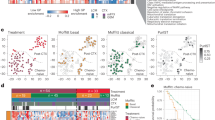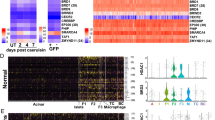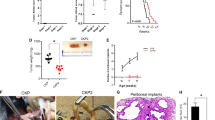Abstract
Although subtypes of pancreatic ductal adenocarcinoma (PDAC) have been described, this malignancy is clinically still treated as a single disease. Here we present patient-derived models representing the full spectrum of previously identified quasi-mesenchymal (QM-PDA), classical and exocrine-like PDAC subtypes, and identify two markers—HNF1A and KRT81—that enable stratification of tumors into different subtypes by using immunohistochemistry. Individuals with tumors of these subtypes showed substantial differences in overall survival, and their tumors differed in drug sensitivity, with the exocrine-like subtype being resistant to tyrosine kinase inhibitors and paclitaxel. Cytochrome P450 3A5 (CYP3A5) metabolizes these compounds in tumors of the exocrine-like subtype, and pharmacological or short hairpin RNA (shRNA)-mediated CYP3A5 inhibition sensitizes tumor cells to these drugs. Whereas hepatocyte nuclear factor 4, alpha (HNF4A) controls basal expression of CYP3A5, drug-induced CYP3A5 upregulation is mediated by the nuclear receptor NR1I2. CYP3A5 also contributes to acquired drug resistance in QM-PDA and classical PDAC, and it is highly expressed in several additional malignancies. These findings designate CYP3A5 as a predictor of therapy response and as a tumor cell–autonomous detoxification mechanism that must be overcome to prevent drug resistance.
This is a preview of subscription content, access via your institution
Access options
Subscribe to this journal
Receive 12 print issues and online access
$209.00 per year
only $17.42 per issue
Buy this article
- Purchase on Springer Link
- Instant access to full article PDF
Prices may be subject to local taxes which are calculated during checkout






Similar content being viewed by others

Accession codes
Primary accessions
ArrayExpress
Referenced accessions
NCBI Reference Sequence
References
Hidalgo, M. Pancreatic cancer. N. Engl. J. Med. 362, 1605–1617 (2010).
Malvezzi, M., Bertuccio, P., Levi, F., La Vecchia, C. & Negri, E. European cancer mortality predictions for the year 2014. Ann. Oncol. 25, 1650–1656 (2014).
Siegel, R.L., Miller, K.D. & Jemal, A. Cancer statistics, 2015. CA Cancer J. Clin. 65, 5–29 (2015).
Burris, H.A. III et al. Improvements in survival and clinical benefit with gemcitabine as first-line therapy for patients with advanced pancreas cancer: a randomized trial. J. Clin. Oncol. 15, 2403–2413 (1997).
Conroy, T. et al. FOLFIRINOX versus gemcitabine for metastatic pancreatic cancer. N. Engl. J. Med. 364, 1817–1825 (2011).
Von Hoff, D.D. et al. Increased survival in pancreatic cancer with nab-paclitaxel plus gemcitabine. N. Engl. J. Med. 369, 1691–1703 (2013).
Vincent, A., Herman, J., Schulick, R., Hruban, R.H. & Goggins, M. Pancreatic cancer. Lancet 378, 607–620 (2011).
Moore, M.J. et al. Erlotinib plus gemcitabine compared with gemcitabine alone in patients with advanced pancreatic cancer: a phase 3 trial of the National Cancer Institute of Canada clinical trials group. J. Clin. Oncol. 25, 1960–1966 (2007).
Biankin, A.V. & Maitra, A. Subtyping pancreatic cancer. Cancer Cell 28, 411–413 (2015).
Kim, S. et al. Identifying molecular subtypes related to clinicopathologic factors in pancreatic cancer. Biomed. Eng. Online 13, S5 (2014).
Collisson, E.A. et al. Subtypes of pancreatic ductal adenocarcinoma and their differing responses to therapy. Nat. Med. 17, 500–503 (2011).
Guengrich, F.P. in Comprehensive Toxicology 2nd edn. (ed. McQueen, C.A.) 9.43–9.76 (Elsevier Ltd., Oxford, 2010).
Rochat, B. Role of cytochrome P450 activity in the fate of anticancer agents and in drug resistance: focus on tamoxifen, paclitaxel and imatinib metabolism. Clin. Pharmacokinet. 44, 349–366 (2005).
Bruno, R.D. & Njar, V.C.O. Targeting cytochrome P450 enzymes: a new approach in anticancer drug development. Bioorg. Med. Chem. 15, 5047–5060 (2007).
Michael, M. & Doherty, M.M. Drug metabolism by tumors: its nature, relevance and therapeutic implications. Expert Opin. Drug Metab. Toxicol. 3, 783–803 (2007).
Yachida, S. & Iacobuzio-Donahue, C.A. Evolution and dynamics of pancreatic cancer progression. Oncogene 32, 5253–5260 (2013).
Biankin, A.V. et al. Pancreatic cancer genomes reveal aberrations in axon-guidance pathway genes. Nature 491, 399–405 (2012).
Jones, S. et al. Core signaling pathways in human pancreatic cancers revealed by global genomic analyses. Science 321, 1801–1806 (2008).
Uhlen, M. et al. Toward a knowledge-based Human Protein Atlas. Nat. Biotechnol. 28, 1248–1250 (2010).
Wolfgang, C.L. et al. Recent progress in pancreatic cancer. CA Cancer J. Clin. 63, 318–348 (2013).
Hruban, R.H., Pitman, M.B. & Klimstra, D.S. Tumors of the Pancreas 6th edn. (American Registry of Pathology, Washington, D.C., 2007).
Hong, D.S. et al. A phase 1 study of gemcitabine combined with dasatinib in patients with advanced solid tumors. Invest. New Drugs 31, 918–926 (2013).
George, T.J. Jr., Trevino, J.G. & Liu, C. Src inhibition is still a relevant target in pancreatic cancer. Oncologist 19, 211 (2014).
Trevino, J.G. et al. Inhibition of SRC expression and activity inhibits tumor progression and metastasis of human pancreatic adenocarcinoma cells in an orthotopic nude mouse model. Am. J. Pathol. 168, 962–972 (2006).
Ling, J. et al. Metabolism and excretion of erlotinib, a small-molecule inhibitor of epidermal growth factor receptor tyrosine kinase, in healthy male volunteers. Drug Metab. Dispos. 34, 420–426 (2006).
Christopher, L.J. et al. Metabolism and disposition of dasatinib after oral administration to humans. Drug Metab. Dispos. 36, 1357–1364 (2008).
Li, J., Zhao, M., He, P., Hidalgo, M. & Baker, S.D. Differential metabolism of gefitinib and erlotinib by human cytochrome P450 enzymes. Clin. Cancer Res. 13, 3731–3737 (2007).
Wang, L. et al. Identification of the human enzymes involved in the oxidative metabolism of dasatinib: an effective approach for determining metabolite formation kinetics. Drug Metab. Dispos. 36, 1828–1839 (2008).
Barretina, J. et al. The Cancer Cell Line Encyclopedia enables predictive modeling of anticancer drug sensitivity. Nature 483, 603–607 (2012).
Ding, X. & Zhang, Q.Y. in Comprehensive Toxicology 2nd edn. (ed. McQueen, C.A.) 4.9–4.29 (Elsevier, Oxford, 2010).
Jänne, P.A., Gray, N. & Settleman, J. Factors underlying sensitivity of cancers to small-molecule kinase inhibitors. Nat. Rev. Drug Discov. 8, 709–723 (2009).
Haaz, M.C., Rivory, L., Riché, C., Vernillet, L. & Robert, J. Metabolism of irinotecan (CPT-11) by human hepatic microsomes: participation of cytochrome P450 3A and drug interactions. Cancer Res. 58, 468–472 (1998).
Sonnichsen, D.S. & Relling, M.V. Clinical pharmacokinetics of paclitaxel. Clin. Pharmacokinet. 27, 256–269 (1994).
Burk, O. et al. The induction of cytochrome P450 3A5 (CYP3A5) in the human liver and intestine is mediated by the xenobiotic sensors pregnane X receptor (PXR) and constitutively activated receptor (CAR). J. Biol. Chem. 279, 38379–38385 (2004).
Burk, O. & Wojnowski, L. Cytochrome P450 3A and their regulation. Naunyn Schmiedebergs Arch. Pharmacol. 369, 105–124 (2004).
Tirona, R.G. et al. The orphan nuclear receptor HNF-4α determines PXR- and CAR-mediated xenobiotic induction of CYP3A4. Nat. Med. 9, 220–224 (2003).
Tompkins, L.M. & Wallace, A.D. Mechanisms of cytochrome P450 induction. J. Biochem. Mol. Toxicol. 21, 176–181 (2007).
Yuan, X. et al. Identification of an endogenous ligand bound to a native orphan nuclear receptor. PLoS One 4, e5609 (2009).
Koutsounas, I., Theocharis, S., Patsouris, E. & Giaginis, C. Pregnane X receptor (PXR) at the crossroads of human metabolism and disease. Curr. Drug Metab. 14, 341–350 (2013).
Wu, B., Li, S. & Dong, D. 3D structures and ligand specificities of nuclear xenobiotic receptors CAR, PXR and VDR. Drug Discov. Today 18, 574–581 (2013).
Michael, M. & Doherty, M.M. Tumoral drug metabolism: overview and its implications for cancer therapy. J. Clin. Oncol. 23, 205–229 (2005).
Pavek, P. & Dvorak, Z. Xenobiotic-induced transcriptional regulation of xenobiotic-metabolizing enzymes of the cytochrome P450 superfamily in human extrahepatic tissues. Curr. Drug Metab. 9, 129–143 (2008).
Ding, X. & Kaminsky, L.S. Human extrahepatic cytochromes P450: function in xenobiotic metabolism and tissue-selective chemical toxicity in the respiratory and gastrointestinal tracts. Annu. Rev. Pharmacol. Toxicol. 43, 149–173 (2003).
Downie, D. et al. Profiling cytochrome P450 expression in ovarian cancer: identification of prognostic markers. Clin. Cancer Res. 11, 7369–7375 (2005).
Hukkanen, J. et al. Induction and regulation of xenobiotic-metabolizing cytochrome P450s in the human A549 lung adenocarcinoma cell line. Am. J. Respir. Cell Mol. Biol. 22, 360–366 (2000).
Murray, G.I., Patimalla, S., Stewart, K.N., Miller, I.D. & Heys, S.D. Profiling the expression of cytochrome P450 in breast cancer. Histopathology 57, 202–211 (2010).
Bergheim, I. et al. Cytochrome P450 levels are altered in patients with esophageal squamous-cell carcinoma. World J. Gastroenterol. 13, 997–1002 (2007).
Dhaini, H.R. et al. Cytochrome P450 CYP3A4/5 expression as a biomarker of outcome in osteosarcoma. J. Clin. Oncol. 21, 2481–2485 (2003).
Gharavi, N. & El-Kadi, A.O.S. Expression of cytochrome P450 in lung tumor. Curr. Drug Metab. 5, 203–210 (2004).
McFadyen, M.C., Melvin, W.T. & Murray, G.I. Cytochrome P450 CYP1B1 activity in renal cell carcinoma. Br. J. Cancer 91, 966–971 (2004).
Oyama, T. et al. Expression of cytochrome P450 in tumor tissues and its association with cancer development. Front. Biosci. 9, 1967–1976 (2004).
Oyama, T. et al. Cytochrome P450 in non-small-cell lung cancer related to exogenous chemical metabolism. Front. Biosci. (Schol. Ed.) 4, 1539–1546 (2012).
Schmidt, R. et al. CYP3A4, CYP2C9 and CYP2B6 expression and ifosfamide turnover in breast cancer tissue microsomes. Br. J. Cancer 90, 911–916 (2004).
Sugawara, M. et al. Expressions of cytochrome P450, UDP-glucuronosyltranferase and transporter genes in monolayer carcinoma cells change in subcutaneous tumors grown as xenografts in immunodeficient nude mice. Drug Metab. Dispos. 38, 526–533 (2010).
Basseville, A. et al. Irinotecan induces steroid and xenobiotic receptor (SXR) signaling to detoxification pathway in colon cancer cells. Mol. Cancer 10, 80 (2011).
Kuehl, P. et al. Sequence diversity in CYP3A promoters and characterization of the genetic basis of polymorphic CYP3A5 expression. Nat. Genet. 27, 383–391 (2001).
Westlind-Johnsson, A. et al. Comparative analysis of CYP3A expression in human liver suggests only a minor role for CYP3A5 in drug metabolism. Drug Metab. Dispos. 31, 755–761 (2003).
Walsky, R.L. et al. Selective mechanism-based inactivation of CYP3A4 by CYP3cide (PF-04981517) and its utility as an in vitro tool for delineating the relative roles of CYP3A4 versus CYP3A5 in the metabolism of drugs. Drug Metab. Dispos. 40, 1686–1697 (2012).
Vermeulen, L. et al. Single-cell cloning of colon cancer stem cells reveals a multilineage differentiation capacity. Proc. Natl. Acad. Sci. USA 105, 13427–13432 (2008).
Subramanian, A. et al. Gene set enrichment analysis: a knowledge-based approach for interpreting genome-wide expression profiles. Proc. Natl. Acad. Sci. USA 102, 15545–15550 (2005).
Li, B. & Dewey, C.N. RSEM: accurate transcript quantification from RNA-seq data with or without a reference genome. BMC Bioinformatics 12, 323 (2011).
Leek, J.T., Johnson, W.E., Parker, H.S., Jaffe, A.E. & Storey, J.D. The sva package for removing batch effects and other unwanted variation in high-throughput experiments. Bioinformatics 28, 882–883 (2012).
Parker, H.S., Corrada Bravo, H. & Leek, J.T. Removing batch effects for prediction problems with frozen surrogate variable analysis. PeerJ 2, e561 (2014).
Huber, W., von Heydebreck, A., Sültmann, H., Poustka, A. & Vingron, M. Variance stabilization applied to microarray data calibration and to the quantification of differential expression. Bioinformatics 18 (suppl. 1), S96–S104 (2002).
Tusher, V.G., Tibshirani, R. & Chu, G. Significance analysis of microarrays applied to the ionizing radiation response. Proc. Natl. Acad. Sci. USA 98, 5116–5121 (2001).
Stenzinger, A. et al. High SIRT1 expression is a negative prognosticator in pancreatic ductal adenocarcinoma. BMC Cancer 13, 450 (2013).
R Development Core Team. R: A Language and Environment for Statistical Computing (R Foundation for Statistical Computing, 2008).
Acknowledgements
We thank E. Soyka, S. Bauer and A. Hieronymus for excellent technical assistance. We also thank the microarray and the next-generation sequencing (NGS) unit of the Genomics and Proteomics Core Facility, DKFZ, for providing expression profiling, NGS and related services, and all members of the flow cytometry core facility for excellent support. We thank DKFZ-HIPO for technical support and funding through grant no. HIPO-015 (M.S., R.E., N.A.G., O.S., T.H., A.T. and M.R.S.). This work was supported in part by the Dietmar Hopp Foundation and the BioRN Spitzencluster 'Molecular- and Cell-based Medicine' (E.M.N., C.E., E.E., C.K., V.V., W.N., C.R., J.E., F.M.Z., A.T. and M.R.S.), the German Bundesministerium für Bildung und Forschung (BMBF) e:Med program for systems biology (PANC-STRAT consortium, grant no. 01ZX1305; A.T., M.R.S., M.S., R.E., N.A.G., T.H., O.S., A.S., A.M. and W.W.), the Helmholtz Preclinical Comprehensive Cancer Center (E.E., A.T. and M.R.S.) and the DKFZ-NCT program NCT3.0 (A.T., M.R.S., O.E., M.S., R.E., N.A.G., T.H. and O.S.). A.S. was supported by a fellowship from the NCT–Heidelberg School of Oncology (HSO). E.E. is recipient of an EMBO long-term fellowship (ALTF 344-2013). The collection and processing of the specimens via PancoBank was supported by Heidelberger Stiftung Chirurgie (M.W.B.), BMBF (grant no. 01GS08114; M.W.B.) and Biomaterial Bank Heidelberg–BMBH (BMBF grant no. 01EY1101; A.S. and W.W.).
Author information
Authors and Affiliations
Contributions
E.M.N. and C.E. share first authorship, and A.S. and E.E. share second authorship of this paper. E.M.N. and C.E. established, conducted and analyzed the experiments; A.S., A.M. and W.W. performed immunohistological analyses of all of the tissue specimens presented and performed respective data analyses; E.E. did the immunofluorescence staining experiments and analyses on publicly available data sets; B.K., W.N. and C.R. performed RNA expression analyses on the PDAC validation cohort; C.K., V.V., J.E., F.M.Z., O.E., M.S. and R.E. provided technical and experimental support; C.L. and M.K. conducted and analyzed LC-MS/MS experiments; X.J. and A.K.-S. performed activity area calculations; P.N., M.B. and B.V.S. provided PDAC tissue microarray characterization; N.A.G., T.H., O.S., J.W. and M.W.B. provided samples of individuals with PDAC; A.T. and M.R.S. supervised the project; E.N., C.E., A.T. and M.R.S. developed the concept, designed experimental studies, analyzed the data and wrote the manuscript.
Corresponding authors
Ethics declarations
Competing interests
The authors declare no competing financial interests.
Supplementary information
Supplementary Text and Figures
Supplementary Figures 1–6 and Supplementary Tables 1–12 (PDF 1577 kb)
Rights and permissions
About this article
Cite this article
Noll, E., Eisen, C., Stenzinger, A. et al. CYP3A5 mediates basal and acquired therapy resistance in different subtypes of pancreatic ductal adenocarcinoma. Nat Med 22, 278–287 (2016). https://doi.org/10.1038/nm.4038
Received:
Accepted:
Published:
Issue Date:
DOI: https://doi.org/10.1038/nm.4038
This article is cited by
-
Functional noninvasive detection of glycolytic pancreatic ductal adenocarcinoma
Cancer & Metabolism (2022)
-
Das duktale Adenokarzinom des Pankreas: Subtypen und Molekularpathologie
Der Pathologe (2021)
-
TNF-α-producing macrophages determine subtype identity and prognosis via AP1 enhancer reprogramming in pancreatic cancer
Nature Cancer (2021)
-
Identification of a robust functional subpathway signature for pancreatic ductal adenocarcinoma by comprehensive and integrated analyses
Cell Communication and Signaling (2020)
-
Novel methods for in vitro modeling of pancreatic cancer reveal important aspects for successful primary cell culture
BMC Cancer (2020)


